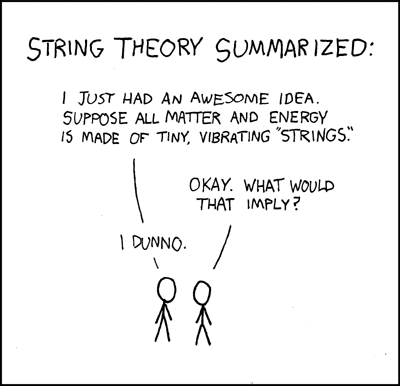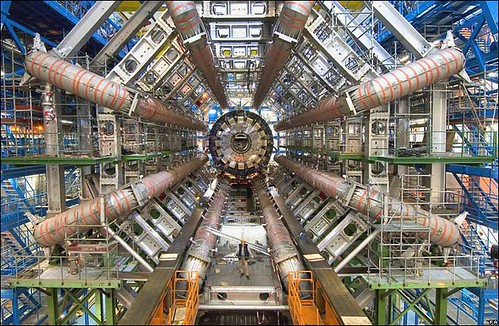
As always, xkcd cuts right to the heart of things.
Simply put, string theory elegantly exploits the physical principles of music; that is, plucking a string will generate a different sound, depending on the properties of the string and how hard it is plucked. Some variations of string theory predict that strings are open, with two endpoints, while others predict that strings are closed, like a loop. Either way, it is the specific modes of vibration, or excitations, of the string that give rise to different kinds of particles.
String theorists conceive of elementary particles as having a very small dimension of length, rather than being point particles with no length, width or height. It may seem like a simple change, but this assumption neatly does away with the problems scientists have always faced when trying to formulate a quantum theory of gravity. There is only one problem: scientists have had no way to test the predictions of string theory. Because strings are thought to be so incredibly small, particle accelerators would have to operate at astronomically high energies to probe deeply enough into the subatomic realm. We simply don't have the technology.

Not even CERN has the power to probe the mysteries of string theory.
Image courtesy of Image Editor.
But a new discovery by a researcher at Imperial College London might be about to change things. According to Professor Mike Duff, the math scientists use to apply string theory to black holes is exactly the same as the math that is used to describe quantum entanglement between three particles. In a paper published in this week's Physical Review Letters, Duff and his team of colleagues detail an experiment involving four entangled particles and predict the result based on the mathematics of string theory. If researchers can manage to carry out this experiment, and if the results agree with the team's predictions, string theory will finally have the experimental backing scientists have been seeking for decades.
Currently, there seems to be no practical connection between quantum entanglement and the string physics of black holes. Even Duff acknowledges that they are "unexpected and unrelated" areas of physics. Perhaps researchers are about to discover more than they bargained for. Or perhaps all of this is simply an odd, yet serendipitous, coincidence.
No comments:
Post a Comment